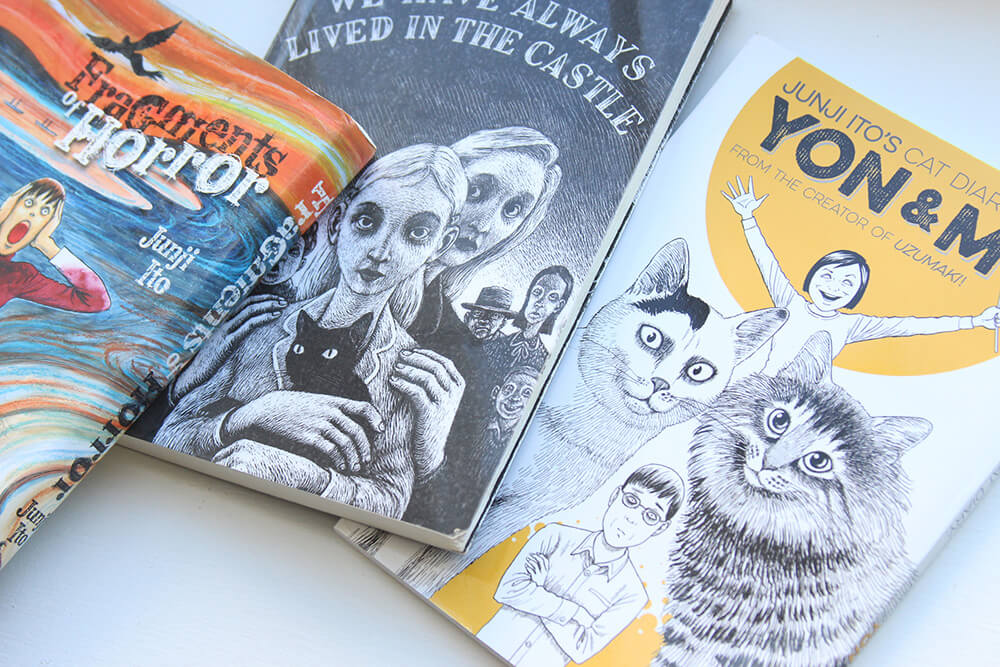
This collection of book is a little spooky related. We have a collection of short horror comics by Junji Ito, a suspense horror by Shirley Jackson, and a collection of comedic stories about cats, which uses a lot of horror tropes. Maybe I was feeling the super old school vibes of reading ghost stories during Christmas time? Perhaps not. I partly wrote up these book reviews in such a small grouping because I checked out We Have Always Lived in the Castle from my library. But it is nice to be able to write only 3 reviews instead of 8 all at once.
What I am Currently Reading
Imperium: A Fiction of the South Seas – I was reading an article about a vegetarian who lived only on coconuts. Surprise he died of malnutrition! The man inspired this story, and thought it would be an interesting read.
What I’ve Read
I am a big fan of Junji Ito, he wrote my first graphic novel- Uzumaki. I managed to then search high and low for his english translations of Tomie (which a used copy of this book sells for $110 on amazon, anyone want to buy my copy?) Then he came out with Gyo, and I still loved his creativity with the horror genre. Then there was a dry spell. Not much was being translated and released in the United States, turns out Ito took a long break from writing horror comics. Fragments of Horror is his first collection of horror comics in eight years. Part of his time away from horror was filled in with his manga about the life of his pet cats (which I have a review below!)
Unlike his previous releases, there is no connecting thread with each story. Each story is it’s own individual story. Some are strong and others I could of done without. The book starts off with Futon, which is a story about a man who refuses to leave his futon due to the demons that he alone can see. The story is told from the point of view of his concerned wife. I thought this was a really strong story, short and to the point. It wasn’t anything insanely original, but the drawings are great.
The next story is a much longer one called The Wooden Spirit. A father and daughter prepare their house as they will start doing tours of the historical building. They get visited by a woman who seems to be very excited about the building. She stays with the family, but the daughter can’t quite figure out what is so weird about this woman. It ends up being a story about obsession and stranger danger.
Tomio – Red Turtleneck reminds me a lot of the Tomie series, a woman that mesmerizes men to their death. Tomio appears at his ex-girlfriends apartment asking for help, his head is about to fall off. His girlfriend is pretty distraught as she was dumped for a fortune teller they both went to. The story didn’t have too much going for it, and mostly was there for gore factors of a head coming off. Plus the “deadly hot” girl story has been done enough with the Tomie storyline.
I was much more impressed by Gentle Goodbye. Riko got married and lives with new parents. Her new home is very weird, she gets the cold shoulder from her in-laws, and she is convinced there is something creeping around the house. Turns out the family has a tradition of turning the recently dead family members into ghosts who fade away as everyone forgets them. The tradition is really weird, and Riko gets a lot backlash from her in-laws when she asks to turn her father into a spirit. It is a nice little ghost story.
Dissection-chan was a short story that I didn’t like right away, but it has grown on me. The story is about a girl who stalks a boy into adulthood, demanding he dissect her. There isn’t too much to this story, but it does create an eerie atmosphere that I can apprieciate. The story builds to the end, which I can imagine would be hard as the story doesn’t have an easy to solve plot. I am sure it wasn’t suppose to have any specific commentary, but as a vegan I saw a lot of parallels with live animal dissections.
Blackbird tells tells the story of Kume, a man who finds an injured hiker. The injured hiker is rushed to hospital, where he tells his story about how he had been hurt in the woods for an entire month to reporters. But how did he stay alive with so little food? The hiker confides in Kume about a mysterious visitor who fed him some unknown raw meat, but wouldn’t save him. The hiker was afraid he might still be visited by this women even though he was now saved. This is a really interesting story and reminds me of some of the traditional Japanese folklore. The women was a little distracting with her big puffy lips since she was suppose to be similar to a bird.
My least favorite story from the whole book was Megami Nanakuse. The story is about Kaoru, a woman who is an avid fan of the novelist Megami Nanakuse. Kaoru sends a fan letter to Nanakuse, and hears back with a special invitation to learn how to write. When she arrives she finds out that her idol isn’t as amazing as she once thought. This story is more filled with humor, but more potty humor that felt a little awkward and misplaced. It felt more awkward that the story seems to use a cross dressing man as a punchline. The story made me think of Misery only in reverse, where the author is using their fans against their will as their muse.
The last story is Whispering Woman, which was a horror concept that was completely new to me. The story is of Mayumi who is plagued with constant indecision, should she sit? should she sit with crossed legs? On the bed? On the floor? So her father hires someone to walk with her all day telling her in detail what to do. The work is hard so they don’t last much longer than a month, until Mitsu shows up. She and Mayumi seem to form a bond that went beyond everyones expectations. Mayumi’s father is a little suspicious about the relationship, everything is seeming to work too well. I have to say the ending was very different, and surprising to me, making this a great way to end the collection.
Overall, I loved and cherished this collection of stories, but I am a fan of Junji Ito. If someone was brand new to the author, I don’t think this would be the best way to start out. Even the author Junji Ito admits that he was a little rusty with the genre after taking such a long break. It is funny reading reviews on Goodreads since there is a lot of divide on which stories were everyones favorites. It felt great to get some new material from one of my favorite artists.

Junji Ito’s Cat Diary: Yon & Mu
Another Christmas gift was Junji Ito’s comic Yon & Mu. As mentioned above, Junji Ito is a horror manga/comic artist. He decided to take a turn and write a comic that centers on some real life experiences. The story starts out with him and his wife moving into a newly built house, something that is fairly rare in Japan. His wife almost immediately asks if Junji is a cat person or a dog person, starting the the couple down the path of cat ownership. As someone who adopted a cat with my husband, I had lived with cats for a small amount of time, and he had not. So the stories made me think of when Jon first tried to win our cat Toulouse’s heart, and kind-of failed miserably at first. He tried so hard to get Toulouse to like him, but we all know cats like to have their own personal space.
What makes the comic work is Ito’s wonderful drawing. He captures movement very well, making a joke come to life that would normally be hard to make work on paper, like his illustrations on how to play with cats. He also uses his horror background to create humor. He first draws the new cats as possessed intruders, and slowly transforms himself into an cat obsessed freak. And let’s face it, if you like cats, you probably know there is something a little weird about you. He also has other great stories that are more so cute and enduring to any pet owner, such as not wanting to disturb sleeping pets.
What is fun about this book for Ito fans is that it does give a look into his personal life. He talks about his relationship with cats, but I was happy to see that they translated Q&A that were posted with original publications. There are even questions about his life before being a manga artist, questions about the current comic, and more. At first I thought they were a joke, which there might of been some tongue in cheek found in some of the answers. But it becomes clear that they are truthful questions and answers. The book ends with a summary of why the comic comes to an end, which is pretty much because of relocation because of the earthquake.
I can safely recommend this book to any cat or comic book fan. Even if you aren’t big on comics, this is a great book since it is filled with lots of humor. It carves it’s own little unique spot in comics since Ito perfectly blends his horror and grotesque drawing styles with light hearted humor. The only downside is that if you are a new reader to Japanese comics, it might take some time getting use to reading everything “backwards.” Once you get use to it, it is really easy to enjoy.
We Have Always Lived in the Castle
I picked up this book because it was recommended by a blogger… who I can’t remember which it was. The person was saying they were in the mood to read something spooky, and this book helped fill the void. I was pretty excited when picking it up, since Shirley Jackson is known for her writing in the horror genre, her most well known piece being The Lottery. The story, just like The Lottery features real life horrors, there aren’t any ghosts, monsters, or zombies.
The story takes place in a small town, where the last of the Blackwood family live together in their mansion. Merricat and Constance take care of their physically impaired Uncle on the last of the family’s money. Constance stays as a recluses in their home after the mysterious death of the family. One night the family was poisoned with arsenic in the sugar, Constance and Merricat didn’t eat any of the sugar, and their Uncle Julian managed to survive the arsenic, but it left him physically damanged. Constance was accused of murder, was found innocent. Merricat ventures out twice a week to get groceries, where she is harassed by the local villagers.
The major theme of the story is outsiderness. We find out that the Blackwood family treated the locals poorly. They didn’t want mix and mingle with people who were lower than them on the social ladder. They blocked their lawn from being used by other people and they moved far away from the village. Merricat and Constance keep in contact with only one person from the outside who is another rich socialite, who also keeps a clear distinction between the rich and the poor. Because of this, the locals in the town hate the family, along with resentment that Constance wasn’t committed for murder.
The story is told through they eyes of Merricat. Her isolation makes her extremely childlike, which is disturbing when paired with her sociopathic mindset. There is a small air of witchcraft in the book since the girls lives revolve around ritual, gardening, and sympathetic magic. There is nothing overtly pointing out that the Blackwood family might be witches, as the Merricat seems to not be aware of her specific actions. But she has a wide knowledge of poisonous and healing plants, performs small acts of magic such as nailing a book to a tree and burying coins, and in the beginning of the book she makes a very specific reference to warewolves. Merricat is the anti hero of the novel, we shouldn’t like her so much but we can’t help be feel sympathetic to her.
I really enjoyed the book, but it does start out a little slow. Once the story hits it’s climax it really comes to an end really quickly. This is a great spooky story to read, especially if you are getting a little bored with the typical supernatural story.














